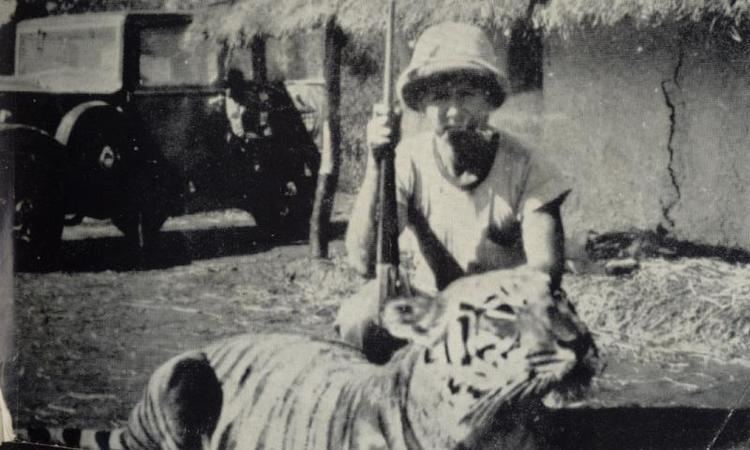 | ||
The Tigress of Jowlagiri was a man-eating Bengal tigress responsible for the deaths of 15 people over an area extending Jowlagiri in the extreme north, to Gundalam 30 miles to the south; and from the borders of Mysore State to the west. She was killed by Kenneth Anderson.
Contents
First hunt for the tigress
The tigress first made her presence known by calling in the vicinity of a village in the Jowlagiri Forest Range, after a poacher killed her mate. After a week, a young hunter named Jack Leonard arrived at the village and concealed himself behind an anthill at 5 in the afternoon. At 6:15, Leonard spotted the animal and fired at her, wounding her shoulder. The tigress bounded off into the impenetrable jungle, where the terrain proved too harsh for Leonard to pursue her.
A few months later, at the village of Sulekunta seven miles from Jowlagiri, the tigress claimed her first human victim; a boy aged sixteen, whilst picking acid fruits.
Second hunt for the tigress
Kenneth Anderson was informed of the subsequent attacks by the Sub-Collector of Hosur. By this time, 15 people, including three girls, one just married, had been killed by the tigress. Anderson journeyed from Jowlagiri to Sulekunta, hoping to find fresh tracks, but was unsuccessful. Anderson moved camp to Gundalam 23 miles away at the southern limit of the affected area, where the majority of attacks had been reported. Seven herdsman had been taken in this area in the previous four months. Anderson received three domestic buffalo baits from the Sub-Collector; the first of which he tied near a river in Gundalam, the second he tied to a path leading to the nearby village of Anchetty four miles away, the third he tied near a watershed. Anderson explored the forest with his .405 Winchester, finding fresh tracks two days later on the sand of the Gundalam river. The buffalo was alive and untouched. The next day, a group of men from a hamlet a mile south of Anchetty, saying that a man had been killed by the tigress in his cattle pen. Upon arriving at Anchetty, Anderson followed the tigress’ trail, where he found the victim’s body dragged deep into the surrounding jungle. Positioning himself above the corpse on a high ledge, Anderson hoped to catch the tigress when she returned to finish her meal. After waiting several hours in the dark, Anderson sensed the tigress’ presence, and upon turning around, saw the tigress above him, ready to pounce. Anderson missed, blowing one of the tigress’ ears off, causing her to retreat from the site.
Third hunt for the tigress
Anderson remained in the locality of Gundalam for a further 10 days with no success in tracking the tigress. On the eleventh day, he left Gundalam for his home in Bangalore, promising the Sub-Collector that he would return should another attack be reported. Three months later, Anderson received a verified account of a tiger in Gundalam involving an old priest being killed at the door of a temple in Sulekunta. Anderson went to Gundalam to learn more of the attack. All eyewitnesses to the attack and others confirmed that the animal was missing an ear. Three days later, Anderson received news from Jowlagiri stating that the night-watchman of Jowlagiri Forest Reserve had also been killed. Knowing that the tigress would not strike at the same place twice in a row, Anderson returned to the temple at Sulekunta with 12 men, where the tigress was heard calling. Anderson imitated the calls, attracting the tigress to his location. When the tigress approached, Anderson recognized her by her missing ear. Before the tigress could realise the deception, Anderson fired his .405 into her forehead and finished the animal with a shot to the back of the neck.
Anderson expressed regret at his strategy, having later written;
“The dreaded killer of Jowlagiri had come to a tame and ignominious end, unworthy of her career, and although she had been a murderer, silent, savage and cruel, a pang of conscience troubled me as to my unsporting ruse in encompassing her end.”
